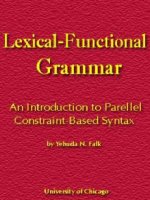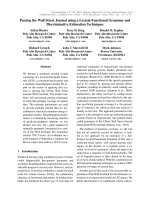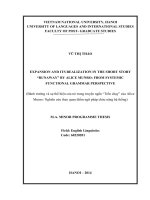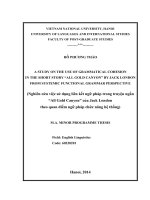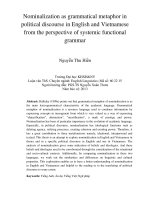Functional Grammar COHESION DISCOURSE
Bạn đang xem bản rút gọn của tài liệu. Xem và tải ngay bản đầy đủ của tài liệu tại đây (1.23 MB, 106 trang )
Functional
Grammar
COHESION
& DISCOURSE
Group 6 - K18:
Nguyễn Thị Hương
Đặng Phương Mai
Vũ Thị Mẫu
Hoàng Trà My
Bùi Thị Nga
1
MAIN CONTENTS
The concept of cohesion
1
2
Reference
3
4
5
6
Ellipsis and Substitution
Conjunction
Lexical cohesion
The creation of texture
2
MAIN CONTENTS
The concept of cohesion
1
2
Reference
3
4
5
6
Ellipsis and Substitution
Conjunction
Lexical cohesion
The creation of texture
3
1. The concept of Cohesion
1.1. Text
1.2. Texture
1.3. Ties
1.4. Cohesion
1.5. Types of cohesion
4
1.1. Text
Any
passage, spoken or written, of
whatever length, that does form a
unified whole A unit of language in use,
not a grammatical unit.
A semantic unit: a unit not of form but of
meaning
REALIZATION relation with a clause or
sentence
(Halliday & Hasan, 1976:1)
5
1.2. Texture
“Property
of being a text”
A text has texture. A text is characterized
by texture.
A text that has a texture functions as a
unity with respect to its environment
(Halliday & Hasan, 1976: 2)
6
1.3. Ties
A single
instance of cohesion
One occurrence of a pair of cohesively
related items
6 different kinds of cohesive ties:
reference,
substitution,
ellipsis,
conjunction, and lexical cohesion.
7
1.4. Cohesion
Semantic
concept
relations
of
meaning that exist within the text, and
that define it as a text
Cohesion
occurs
where
the
INTERPRETATION of some element in
the discourse is dependent on that of
another. The one PRESUPPOSES the
other
8
1.4. Cohesion (cont)
Actualization
of cohesion depends on
both selection of some option from
systematic resources (reference, ellipsis,
etc) and the presence of some other
element
which
resolves
the
presupposition that this sets up.
Grammatical
cohesion
Lexical cohesion
9
1.4. Cohesion (cont)
Did
I hurt your feelings? I didn’t MEAN
to
Lexical
cohesion: Ellipsis: I didn’t mean
to presupposes hurt your feelings
Grammatical
cohesion: Conjunction:
Tone: the rising-falling tone: “but”
10
1.4. Cohesion (cont)
Little Boy Blue, come and blow your horn!
The sheep’s on the meadow, the cow’s in the
corn
Where is the boy that looks after the sheep?
He’s under the haycock, fast asleep.
Will you go wake him? No, not I!
For if I do, he’ll sure to cry
11
1.4. Cohesion (cont)
Little Boy Blue, come and blow your horn!
The sheep’s on the meadow, the cow’s in the corn
Where is the boy that looks after the sheep?
He’s under the haycock, fast asleep.
Will you go wake him? No, not I!
For if I do, he’ll sure to cry
REFERENCE: a participant or circumstantial
element introduced at one place in the text is
taken as a reference point for something that
follows
12
1.4. Cohesion (cont)
Little Boy Blue, come and blow your horn!
The sheep’s on the meadow, the cow’s in the
corn
Where is the boy that looks after the sheep?
He’s under the haycock, fast asleep.
Will you go wake him? No, not I!
For if I do, he’ll sure to cry
CONJUNCTION: logico-semantic relation
(Halliday, 1985: 289)
13
1.4. Cohesion (cont)
Little Boy Blue, come and blow your horn!
The sheep’s on the meadow, the cow’s in the corn
Where is the boy that looks after the sheep?
He’s under the haycock, fast asleep.
Will you go wake him? No, not I!
For if I do, he’ll sure to cry
ELLIPSIS/
SUBSTITUTION:
Continuity
is
established by omission or by putting a
placeholding element
14
1.4. Cohesion (cont)
Little Boy Blue, come and blow your horn!
The sheep’s on the meadow, the cow’s in the corn
Where is the boy that looks after the sheep?
He’s under the haycock, fast asleep.
Will you go wake him? No, not I!
For if I do, he’ll sure to cry
LEXICAL COHESION: Continuity may be established
by choice of words (repetition, synonymy)
15
1.5. Types of Cohesion
Reference:
2. Ellipsis/ Substitution
3. Conjunction
4. Lexical cohesion
1.
16
MAIN CONTENTS
The concept of cohesion
1
2
Reference
3
4
5
6
Ellipsis and Substitution
Conjunction
Lexical cohesion
The creation of texture
17
2. REFERENCE
Personal
Personal reference
reference
Demonstrative
Demonstrative reference
reference
Types
Types of
of
reference
reference
Comparative
Comparative reference
reference
18
2.1. Personal References
Personal
reference is a mean of linking
“outward” to some person or object in
the environment
The meaning of the first and second
persons I and you is defined in the act of
speaking
The third persons he, she, it, and they
are known as anaphoric
19
2.1. Personal References
Anaphoric
reference:
(pointing
backwards) the meaning that is being
repeated has already been mentioned
earlier in the text
Cataphoric
reference:
(pointing
forwards) this signals that the meaning
of the reference item will not be
specified until further on in the text
20
2.1. Personal References
1. Although Peter is not a singer, he can
sing very well.
2. Mary works in an hospital. She often has
to work in nigh shift.
In this case, the meaning of the pronoun
he and she can be understood by
referring backward to Peter and Mary.
21
2.2. Demonstrative Reference
This/ that/ these/ those
The basic sense of this/ that is one
of proximity. This refers to
something as being “near”, that
refers to something as being “not
near”
22
2.2. Demonstrative Reference: the
The
is one kind of particular kind of
demonstrative reference. The may be
Homophoric: it is self-specifying; there
is only one or at least only one that
makes sense in the context
Cataphoric: the information can be
found in the following text
Anaphoric: the information can be found
in the preceding text
23
Examples
The sun was shining on the sea
homophoric
2. This is the house that Jack built.
cataphoric
3. Algy met a bear. The bear was bulgy.
anaphoric
1.
24
2.2. Demonstrative reference: here and there
1.
2.
Here may be cataphoric or anaphoric
There is anaphoric
Examples:
Here is a question for you. How old did you
say you were?
cataphoric
A: it would be better if you were punished
B: You’ve wrong there.
anaphoric
25
